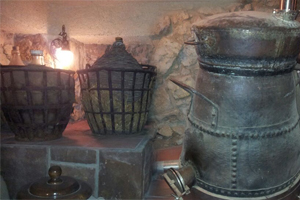-
Patient cooperation of Man & Time

Arak is colorless as water. It still has to be raised and refined to give it, with the complicity of time and clay, that incomparable mellowness and roundness in order to compose the rich bouquet that makes the consistency and renown of ARAK FAKRA .
During the aging period, an essential phenomenon occurs due to the action of time: a sort of oxidation of Arak that breathes through the clay, becomes more refined, takes on mellowness while losing the undesirable substances an enrichment through a constant and mysterious exchange with air. It is indeed an intimate marriage, a fusion by the most absolute mutual agreement. The price of this improvement is evaporation and a decrease in alcohol degree.
Finally there comes a moment when Arak reaches full maturity and the perfect harmony of its constituents, a moment when it gives off the delightfully combined scents of wine and aniseed of which they are the quintessence. It is that precise moment that ARAK FAKRA chooses to fix through the bottling process.
-
Aging in Clay Jars of BEIT-CHABAB

Along with these elements whose pleasant combination gives birth to the new Arak, two others as precious bring the best out of the liquor: the clay of Beit - Chabab of which the jars are made, and time whose action allows to attain that full maturity and the so desirable roundness. Man's sole interference consists in harmonizing, with all his skill and experience, this remarkable work of nature.
Since the Phoenicians and maybe even earlier, baked clay jars were used for storing beverages. It was, then, natural for the Lebanese to use them for the aging of Arak.
Since then, in-spite of numerous experiences, they are still considered the best storage containers thanks to the natural yet mysterious affinity that exists between clay and Arak.
Of course, new jars must undergo a kind of practice in aging. The first liquor is only kept there for a few months while the second is left to age a year or more until the jar can improve the same Arak indefinitely. In the cellars where ARAK FAKRA ages, the product evaporation of 3 to 4% per year is inevitable.
-
The Art of Distilling “ARAK FAKRA”
ARAK FAKRA was born from an Arak distillery founded in the early eighteenth century in Kfardebian by a noble Lebanese family of Mount Lebanon whose members were Consuls of France and Venice.
The distillery is presently equipped with several traditional pot stills and numerous clay jars that give ARAK FAKRA its superior quality and premium taste so appealing to connoisseurs. Fully automated stainless steel bottling units, ion-exchangers, charcoal filters and ultra-violet rays for water-treatment guarantee its superior quality.
-
Soil, Climate, Sunlight & Water
The secret of ARAK FAKRA lies in the combination of two Lebanese vine-plants Obeidi and Merwayh and the anise coming exclusively from the Syrian Hina.
The joyful combination of soil, climate, and sunlight has a major effect on the aroma of both vine and aniseed. Assal and Laban springs add a final touch of delicacy to ARAK FAKRA.
ARAK FAKRA has its own vineyards supplying it with all the grapes it needs. It also has its anise growers sending each season first-quality Hina seeds.
-
ARAK, An Anissed-Flavored liquor

The new wine weighing from 7 to 10 degrees is distilled within the few months following its manufacturing. This process takes place in traditional stills. The reason these equipment have not evolved is that they are the only ones to allow the liquor to acquire the wine's finest aromas recognized and appreciated by the connoisseur.
These stills, on the boiler, consist of the following essential parts: the cucurbit, the head, the neck, and the cooler or serpentine passing through a cold water vat to facilitate the condensation. The distillation is carried out in three stages.
The first gives the brouillis , from 45 to 50 degrees GL, the second produces the good stoke , from 69 to 71 degrees GL which, mixed to aniseed and distilled in turn, gives birth to ARAK FAKRA. These delicate operations are only entrusted to experienced specialists. The heads and tails of distillation must be eliminated and re-distilled since they are loaded with undesirable substances and bad tastes.





